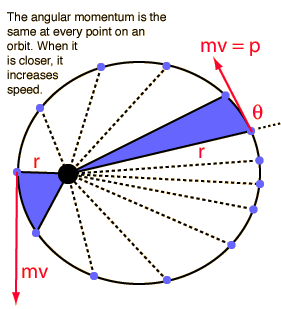This is an important concept because if it were not true, then things could just happen and things could just vanish from our Universe without warning making our Universe inexplicable. A long cherished conservation law is that of the Conservation of Linear Momentum. The conservation of linear momentum is essentially re-stated three times as Newton's 3 Laws of Motion. All of Newton's laws of motion have to do with conservation of linear momentum. The law is so revered that when experiments do not appear to conserve linear momentum, the assumption is not that the law is wrong, but rather that the experimentalists missed something. This belief led to the prediction of a new particle back in the 40's (the neutrino).
Another quantity which is conserved is known as Angular Momentum. This is a measure of the spin motion of an object (as compared to the linear momentum which is a measure of the straight line motion of an object). Technically we have
angular momentum = l = mass x "spinning" speed x distance from "spin" axis

-
Application:
For an object in an elliptical orbit (the distance from
the spin axis varies) ---> the orbital speed will vary. The object must
move faster the closer it is to the spin axis (for the Solar System,
this means the closer it is to the Sun!). This should sound familiar.
This is a re-statment of Kepler's 2nd Law of Planetary Motion. Kepler's
2nd Law of Planetary Motion is a re-statement of the law of conservation
of angular momentum.
Application: Suppose you are on the equator of the Earth and launch a rocket upward. What happens to the trajectory of the rocket as it climbs in altitude? Well, because we launched the rocket from the surface of the Earth, it is given a rotational speed of ~1,000 miles per hour. As it moves away from the Earth, it must slow down to conserve angular momentum. That is, above the surface of the Earth its rotational speed is less than 1,000 miles per hour, and it will be left behind. Oh oh, were the Greeks right? No, reverse the experiment and imagine dropping an object while standing on the top of the Empire State Building. The object will have a rotational speed of > 1,000 miles per hour due to the rotation of the Earth (and the fact that you drop the ball from the top of the Empire State Building). Now, as the object falls toward the Earth, it speeds up to conserve angular momentum ---> rotational speed grows as it falls. The falling object leaves the Earth behind and deflects in the direction in which the Earth spins!
Application: A similar effect arises if you fire cannon along the surface of the Earth. Suppose you are at the equator and fire a shell due North, what happens to the trajectory of the shell? As the shell moves due north, it gets closer to the North Pole (the spin axis of the Earth) ---> its initial rotational speed of 1,000 miles per hour must increase to conserve angular momentum. The shell will deflect toward the East (the direction in which the Earth spins). If I move north of the equator and fire a shell due South, the shell deflects westward.

What happens if I am on the Equator and I fire a shell due south, will it also deflect westward? No, a southward aimed shell will deflect eastward while a northward aimed shell will deflect westward. The sense of the shift changes as you move into the southern hemisphere (the actual direction does not change only the sense of the change). These effects also manifest themselves in terms of the direction of wind circulation on the Earth.
